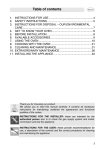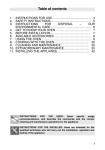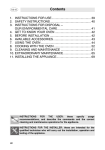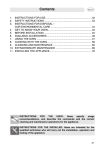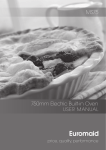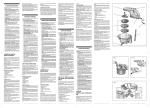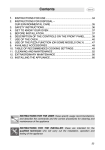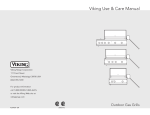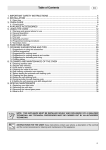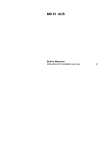Download Instruction manual
Transcript
Table of contents 1. 2. 3. INSTRUCTIONS FOR USE .............................................. 4 SAFETY INSTRUCTIONS ................................................ 5 INSTRUCTIONS FOR DISPOSAL – OUR ENVIRONMENTAL CARE ................................................ 6 4. GET TO KNOW YOUR OVEN .......................................... 7 5. BEFORE INSTALLATION................................................. 7 6. AVAILABLE ACCESSORIES ............................................ 8 7. USING THE OVEN ........................................................... 9 8. COOKING WITH THE OVEN ......................................... 20 9. CLEANING AND MAINTENANCE.................................. 29 10. EXTRAORDINARY MAINTENANCE .............................. 31 11. INSTALLING THE APPLIANCE...................................... 35 INSTRUCTIONS FOR THE USER: these specify usage recommendations, and describe the commands and the correct cleaning and maintenance operations for the appliance INSTRUCTIONS FOR THE INSTALLER: these are intended for the qualified technician who will carry out the installation, operation and testing of the appliance 3 General instructions 1. INSTRUCTIONS FOR USE THIS MANUAL IS AN INTEGRAL PART OF THE APPLIANCE. IT MUST BE KEPT IN ITS ENTIRETY AND IN AN ACCESSIBLE PLACE FOR THE WHOLE WORKING LIFE OF THE OVEN. CAREFUL READING OF THIS MANUAL AND ALL THE INSTRUCTIONS THEREIN BEFORE USING THE APPLIANCE IS ESSENTIAL. INSTALLATION MUST BE CARRIED OUT BY QUALIFIED PERSONNEL IN ACCORDANCE WITH THE REGULATIONS IN FORCE. THIS APPLIANCE IS INTENDED FOR HOUSEHOLD USE AND COMPLIES WITH THE EEC DIRECTIVES CURRENTLY IN FORCE. THE APPLIANCE HAS BEEN BUILT TO CARRY OUT THE FOLLOWING FUNCTIONS: COOKING AND HEATING FOODS; ALL OTHER USES ARE TO BE CONSIDERED IMPROPER. THE MANUFACTURER DECLINES ALL RESPONSIBILITY FOR IMPROPER USE. DO NOT USE THIS APPLIANCE FOR HEATING ROOMS. THIS APPLIANCE IS MARKED ACCORDING TO THE EUROPEAN DIRECTIVE 2002/96/CE ON WASTE ELECTRICAL AND ELECTRONIC EQUIPMENT – (WEEE). THIS GUIDELINE IS THE FRAME OF A EUROPEAN-WIDE VALIDITY OF RETURN AND RECYCLING ON WASTE ELECTRICAL AND ELECTRONIC EQUIPMENT. DO NOT OBSTRUCT VENTILATION OPENINGS AND HEAT DISPERSAL SLITS. DO NOT SPRAY AEROSOLS IN THE VICINITY OF THIS APPLIANCE WHILE IT IS INOPERATION. THIS APPLIANCE IS DESIGNED FOR COOKING FOOD AND IT SHALL NOT BE USED AS A SPACE HEATER. THE I.D. PLATE WITH TECHNICAL DATA, REGISTRATION NUMBER AND BRAND NAME IS POSITIONED VISIBLY ON THE OVEN DOOR FRAME. THE PLATE MUST NOT BE REMOVED. DO NOT USE METALLIC SPONGES OR SHARP SCRAPERS: THEY WILL DAMAGE THE SURFACE. USE ORDINARY NON-ABRASIVE PRODUCTS WITH THE AID OF WOODEN OR PLASTIC UTENSILS IF NECESSARY. RINSE THOROUGHLY AND DRY WITH A SOFT CLOTH OR CHAMOIS LEATHER. DO NOT ALLOW RESIDUES OF SUGARY FOODS (SUCH AS JAM) TO SET INSIDE THE OVEN. IF LEFT TO SET FOR TOO LONG, THEY MIGHT DAMAGE THE ENAMEL LINING OF THE OVEN. 4 General instructions 2. SAFETY INSTRUCTIONS REFER TO THE INSTALLATION INSTRUCTIONS FOR THE SAFETY REGULATIONS FOR ELECTRIC OR GAS APPLIANCES AND VENTILATION FUNCTIONS. IN YOUR INTERESTS AND FOR YOUR SAFETY IT HAS BEEN ESTABLISHED BY LAW THAT THE INSTALLATION AND SERVICING OF ALL ELECTRICAL APPLIANCES IS TO BE CARRIED OUT BY QUALIFIED PERSONNEL IN ACCORDANCE WITH THE REGULATIONS IN FORCE. OUR REGULAR INSTALLERS GUARANTEE A SATISFACTORY JOB. GAS OR ELECTRIC APPLIANCES MUST ALWAYS BE DISCONNECTED BY SUITABLY SKILLED PEOPLE. THE PLUG TO BE CONNECTED TO THE POWER CORD AND ITS SOCKET MUST BE OF THE SAME TYPE AND CONFORM TO THE REGULATIONS IN FORCE. THE SOCKET MUST BE ACCESSIBLE AFTER THE APPLIANCE IS BUILT IN. NEVER DISCONNECT THE PLUG BY PULLING ON THE POWER SUPPLY LEAD. IT IS OBLIGATORY FOR ALL ELECTRICAL SYSTEMS TO BE GROUNDED ACCORDING TO THE METHODS REQUIRED BY SAFETY RULES. IMMEDIATELY AFTER INSTALLATION CARRY OUT A BRIEF INSPECTION TEST, FOLLOWING THE INSTRUCTIONS BELOW. SHOULD THE APPLIANCE NOT FUNCTION, DISCONNECT IT FROM THE SUPPLY AND CALL THE NEAREST TECHNICAL ASSISTANCE CENTRE. NEVER ATTEMPT TO REPAIR THE APPLIANCE. NEVER PUT INFLAMMABLE OBJECTS IN THE OVEN: THEY COULD BE ACCIDENTALLY LIGHTED AND CAUSE FIRES. DURING USE THE APPLIANCE BECOMES VERY HOT. TAKE CARE NOT TO TOUCH THE HEATING ELEMENTS INSIDE THE OVEN. THE USE OF THIS APPLIANCE IS NOT PERMITTED TO PEOPLE (INCLUDING CHILDREN) OF REDUCED PHYSICAL AND MENTAL ABILITY, OR LACKING IN EXPERIENCE IN THE USE OF ELECTRICAL APPLIANCES, UNLESS THEY ARE SUPERVISED OR INSTRUCTED BY ADULTS OR PEOPLE RESPONSIBLE FOR THEIR SAFETY. BEFORE THE APPLIANCE IS PUT INTO OPERATION, ALL THE PROTECTIVE FILMS APPLIED ON THE OUTSIDE MUST BE REMOVED. The manufacturer declines all responsibility for damage to persons or things caused by non-observance of the above prescriptions or by interference with any part of the appliance or by the use of non-original spares. 5 Instructions for disposal 3. INSTRUCTIONS FOR DISPOSAL ENVIRONMENTAL CARE – OUR Our product's packing is made of non-polluting materials, therefore compatible with the environment and recycable. Please help by disposing of the packing correctly. Find the addresses of collection, recycling and disposal centres from your retailer or from the competent local organisations. Do not throw the packing or any part of it away. They can constitute a suffocation hazard for children, especially the plastic bags. Your old appliance also needs to be disposed of correctly. Important: Hand over your appliance to the local agency authorised for the collection of electrical appliances no longer in use. Correct disposal means intelligent recycling of valuable materials. Before disposing of your old appliance remove the door and leave the racks in their normal working positions so that children cannot get stuck in the oven compartment whilst playing. It is also necessary to cut the electric power cord and remove it along with the plug. DO NOT DISCARD PACKING IN THE HOME ENVIRONMENT. SEPARATE THE VARIOUS WASTE MATERIALS AND TAKE THEM TO THE NEAREST SPECIAL GARBAGE COLLECTION CENTRE. 6 Instructions for the user 4. GET TO KNOW YOUR OVEN Control panel Roof liner Oven light Shelf and tray runners Temperature sensor Oven fan Oven door 5. BEFORE INSTALLATION In order to remove all manufacturing residues, it is recommended to clean the inside of the appliance. For further information on cleaning see paragraph "9. CLEANING AND MAINTENANCE". Before using the oven for the first time, pre-heat it to maximum temperature long enough to burn any manufacturing oily residues which could give the food a bad taste. The Turbo function is recommended for this purpose . 7 Instructions for the user 6. AVAILABLE ACCESSORIES Grill: useful for holding cooking containers. Tray grid: for placing on top of a tray for cooking foods which may drip. Oven tray: useful for collecting fat from foods placed on the grid above. Pastry plate (on some models only): for baking cakes, pizza and oven desserts. Chromium-plated gripper: use to remove hot oven racks and pans. Roasting spit: used for roasting chicken, sausages and anything else requiring uniform browning. Rotisserie frame: fits into the slots of the oven pan prior to attaching the rotisserie rod. (see page 28 for instructions for use) Roof liner: remove it to simplify cleaning inside the oven. Accessories available on request: Original supplied and optional accessories may be ordered from any Authorised Service Centre. 8 Instructions for the user 7. USING THE OVEN 7.1 General Description 7.1.1 Oven racks The oven features 4 runners for positioning trays and grills at different heights. The insertions heights are numbered from the bottom upwards (see figure). (When using the recipes, the display will show the recommended runner for the selected recipe). 7.1.2 Cooling system The appliance is equipped with a cooling system which comes into operation as soon as a cooking function starts. The fan cause a steady outflow of air from above the door which may continue for a brief period of time even after the oven has been turned off. 7.1.3 Inside light The oven light comes on when the door is opened or any function or recipe is selected. When set to ON, the oven lights can be switched on/off by briefly pressing the on/off knob. 7.2 Warnings and general advice for usage All cooking operations must be carried out with the door closed. During cooking, do not cover the bottom of the oven with aluminium or tin foil and do not place pans or oven trays on it as these may damage the enamel coating. If you wish to use greaseproof paper, place it so that it will not interfere with the hot air circulation inside the oven. To prevent any steam in the oven creating problems, open the door in two stages: half open (5 cm approx.) for 4-5 seconds and then fully open. To access food, always leave the door open as short a time as possible to prevent the temperature in the oven from falling and ruining the food. To prevent excessive amounts of condensation from forming on the internal glass, food should not be left inside the oven for too long after cooking. 9 Instructions for the user 7.3 Description of the controls on the front panel All the appliance's control and monitoring devices are placed together on the front panel. The symbols used are described in the table below. FUNCTIONS AND SYMBOLS SHOWN: PT1 Functions allows you to set the time, select the cooking Thermostat temperature and duration and program the Knob cooking start and end times. allows access to the oven's three operating PT2 Functions modes, and is also used to select a cooking ON-OFF function or cooking program Knob (see paragraph “7.4 Operating modes”). DSP1 Display current This display shows the current time or the time cooking duration. Programmed cooking procedures The following symbols coming on indicate: Clock: adjusting the cooking time Bell: minute minder activated. Delayed start: setting the cooking time with a delayed start. Cooking duration: setting the cooking time. Recommended runner: recommended runner number according to the selected cooking recipe. Selectable functions 10 Instructions for the user Temperature This display shows the preset temperature Display for the function required, or the temperature DSP2 set by the user. The following symbols coming on indicate: Recommended runner: recommended runner number according to the selected cooking recipe. Temperature inside the The oven is heating up. oven: Child lock-out function mode ON (see “Secondary menu” at page 19). showroom mode ON (see “Secondary menu” Showroom indicator light: at page 19). when flashing it indicates the modification Recipe storing: phase of the selected recipe. Child lock-out function: Selectable recipes 11 Instructions for the user 7.4 Operating modes This appliance is programmed to provide 3 operating settings, which can be modified by pressing PT2. STAND-BY setting: with DSP1 on and showing the current time (activated as soon as the current time has been confirmed). ON setting: from the stand-by setting, press PT2 once. All the displays and knobs light up. If no function is selected within 20 seconds, the oven goes into STAND-BY position automatically. OFF setting: from the ON position, keep PT2 pressed down until it switches off. Only the symbol on DSP1 remains on. 7.5 First use At first use, or after a power failure, the oven's left hand-display, DSP1, will show a flashing symbol . To start any cooking operation, the current time must be set. 7.5.1 Setting the current time Adjusting the current time • turn PT1 to the right and left to increase or decrease the hours. (If the knob is held in one direction the time changes faster). • when PT1 is released, after a few seconds the display will stabilise and only the two dots that separate the hours from the minutes will flash, indicating it is working properly. (The display will also show the symbol ). It might become necessary to change the current time, for example at the switch from summer to winter time. Starting from the stand-by setting, (see paragraph "7.4 Operating modes"), keep PT1 turned to the left or the right in order to enter time adjustment mode. 7.6 Selecting a function In the ON state only, a cooking function can be selected by simply turning PT2 to the right or left. The function selected will change colour to red on the display. After the selection, the preset cooking temperature will be displayed on DSP2. 12 Instructions for the user 7.6.1 Cooking with preset temperature After selection of the function required, the oven will start the cooking procedure at the preset temperature and the symbol will come on. Cooking itself is preceeded by a preheating stage, which allows the oven to heat to the cooking temperature more quickly. The symbol flashes on DSP2 to indicate that this stage is in progress. When the preheating stage is over, the symbol will remain constantly on and a buzzer will sound to indicate that the food can be placed inside the oven. On the pyrolithic models, the special defrosting and proving functions are together in the same symbol . Set the temperature to choose the function: thawing (30°C) or proving (40°C). On the multifunction models, it is not possible to vary the temperature in the defrosting and proving functions. 7.6.2 Changing the preset temperature The temperature preset for each function can be changed to suit the user's requirements. At any time while cooking is in progress, turn PT1 in either direction to increase or decrease the cooking temperature by 5 degrees at a time. (PT1 can also be held in the left or right position to increase or decrease the setting more quickly.) 7.6.3 Using the minute minder Press PT1 once (either in the STAND-BY or ON mode). The display will show the figures (constantly on) and the symbol (flashing). Turn PT1 to set the minutes of cooking (from 00:01 to 03:59:00). A few seconds after the required duration is set, the symbol will stop flashing and stay on constantly; the countdown will start from that moment. Now select the cooking function required and wait for the buzzer to sound, indicating that the cooking time is over. Press PT1 once to switch off the buzzer; extended cooking time can be set by turning PT1. If the minute minder was set in STAND-BY mode, when the oven is activated in ON mode (selection of a cooking operation), the counter is reset to zero. Warning: the minute minder does not stop the cooking process. It only warns the user that the preset number of minutes have passed. To switch the oven off, press PT2. Modifying the data set After setting the countdown, press PT1 once. The symbol starts flashing; turn PT1 to change the set duration. A few seconds after the last change, the symbol will stop flashing, and the countdown will restart from the new value. Changing the cooking function will not cancel the previously set countdown. 13 Instructions for the user 7.7 Programmed cooking procedures 7.7.1 Semiautomatic cooking Semiautomatic cooking is the function which allows a cooking operation to be started and then ended after a specific length of time set by the user. Select a function (see paragraph “7.6 Selecting a function”) and press PT1 twice. The display will show the figures and the symbol (flashing). Turn PT1 to the right or left to set the minutes of cooking (from 00:01 to 23:59). A few seconds after the required duration is set, the symbol will stop flashing, and semiautomatic cooking will start from that moment. At the end, the word STOP will appear on DSP1, cooking will stop and a buzzer will sound; press PT1 to deactivate it. It is also possible to select an additional cooking time semi-automatically by turning PT1. If you wish to continue cooking beyond the set time, press PT1 again. The oven will restart normal operation with the cooking settings selected previously. PT2 has to be pressed to switch the oven off completely. Modifying the data set Once semiautomatic cooking has started, its duration can be changed. When the symbol is steady and cooking is in progress, press PT1 once. The symbol starts flashing and PT1 can be turned to change the set duration. A few seconds after the last change, the symbol will stop flashing, and semiautomatic cooking will restart from the new value. To change the preset temperature, wait for the symbol to become steady and turn PT1 to the right or left to increase or decrease the cooking temperature. Changing the cooking function will not cancel the previously set countdown. 7.7.2 Automatic cooking Automatic cooking is the function which allows a cooking operation to be started at a set time and then ended after a specific length of time set by the user. Select a cooking function, set the cooking temperature required or leave the preset temperature (see paragraph “7.6 Selecting a function”) and press PT1 twice. The display will show the figures and the symbol (flashing). Turn PT1 to the right or left to set the minutes of cooking (from 00:01 to 23:59). 14 Instructions for the user For safety reasons, when setting automatic cooking the user must first program a cooking duration and then set the cooking start time. It is not possible to set the cooking start time only, without setting the cooking duration. After setting the duration, press PT1 once. The symbol and the current time will appear on the display. Turning PT1 to the right increases the time, allowing the cooking start time required to be set. A few seconds after the required duration is set, the and symbols will stop flashing, and the oven will start to wait for the starting time set. While waiting for the start time it is not possible to select another cooking function. At the end, the word STOP will appear on DSP1, cooking will stop and a buzzer will sound; press PT1 once to deactivate it. It is also possible to select an additional cooking time semi-automatically by turning PT1. If you wish to continue cooking beyond the set time, press PT1 again. The oven will restart normal operation with the temperature settings selected previously. PT2 has to be pressed to switch the oven off completely. Modifying the data set Once automatic cooking has started, its duration can be changed. When the and symbols are steady and cooking is in progress, or the oven is in stand-by status waiting for cooking to start, press PT1 once. The symbol starts flashing and PT1 can be turned to change the set duration. Press PT1 again; the symbol goes out, the symbol will start to flash, and the cooking start time will be displayed on DSP1. The cooking start time can be increased or decreased by turning PT1. A few seconds after the last change, the and symbols will appear (in steady mode) on DSP1 and automatic cooking will restart with the new settings. Once cooking has been programmed, before it starts, the function or recipe symbol will remain on, as will the symbols , . 15 Instructions for the user 7.8 Selecting a recipe The oven has 9 preset recipes and 3 memories; a recipe is a preset of function, temperatures, cooking times and shelf position for the dish. In the ON state only, a recipe can be selected by simply turning PT2 to the right or left. The recipe selected will change colour to red on the display. Cooking will start with the preset parameters (symbols on). When the preset temperature is reached, a series of beeps will be emitted indicating that the oven is ready for use. The cooking time as specified in the table “7.9 Table of predefined recipes:”starts from this moment. 7.8.1 Modifying the data set (during cooking) During the cooking it is possible to modify preset temperature turning PT1 to the right of left. To modify the duration press PT1 and turn it to increase or decrease the value. The modification operations to the data set must be carried out when both the symbols , are steady on. 7.8.2 Automatic cooking with a recipe To set automatic cooking, select a recipe and follow the instructions described in paragraph “Automatic cooking” at page 14. The use of this function is recommended in cooking operations that require a preheated oven, such as pizzas and cakes. 16 Instructions for the user 7.8.3 Selecting a recipe permanently The oven has 9 preset recipes (see “Table of predefined recipes:” at page 18), and 3 to set according to your own named cooking preferences . In addition, you can modify the other recipes that are already preset. To modify or set a recipe permanently: 1 From ON status, select the recipe to modify with PT2. Within 5 seconds of the selection, hold down PT1 for at least 2 seconds. The 2 3 4 5 symbol flashes indicating the recipe modification phase. Now, by turning PT1, you can modify the cooking function to associate to the recipe being modified. Press PT1 to confirm. Setting the temperature. The preset temperature will be displayed on DSP2 flashing; press PT1 to modify it. Press PT1 to confirm. Modifying the cooking duration. The preset cooking duration will be displayed on DSP1 flashing. Turning PT1 you can modify it. Press PT1 to confirm. Modifying the recommended runner. The recommended runner will flash; turning PT1 you can modify the number. Press PT1 to exit the programming, the symbol will stop flashing. 17 Instructions for the user 7.9 Table of predefined recipes: Class Type Beef Roast-beef Pork Roast Chicken Roast chicken Lamb Roast leg of lamb Fish Bass baked in foil Vegetables Stuffed peppers Qty. Temp. (°C) Cooking Funct. Runner duration (min.) 0.7 Kg 200 30 1 Kg 200 40 1.5 Kg 200 65 0.5 Kg 180 50 1 Kg 190 85 1.5 Kg 180 110 0.5 Kg 190 40 1 Kg 190 60 2 Kg 180 90 1.0 Kg 190 65 1.5 Kg 180 100 0.7 Kg 200 35 1.0 Kg 200 45 1 Kg 170 45 1.5 Kg 160 50 2 Kg 160 60 Pizza Pizza pie 1 pizza 280 8* Cakes Apple pie 8 people 180 65 Biscuits Lemon biscuits 1 tray 180 20 The cooking times specified in the table refer to the food indicated in the recipe; they are approximate and may vary depending on the weight. The table gives the factory-set data. To reset a recipe with the original settings after it has been modified, just enter the data given in the table. If the PO limiter mode is activated (see secondary menu) the cooking times can vary from those indicated. 18 Instructions for the user 7.10 Secondary menu This appliance also has a concealed "secondary menu" allowing the user to: 1 Activate or deactivate the child safety device 2 Activate or deactivate the Showroom mode (which disables all the heating elements so that only the control panel works). 3 Activate or deactivate low power mode. In OFF status (see "7.4 Operating modes") turn both commands (PT1 and PT2) to the right at the same time and keep them turned for at least 5 seconds. Turning PT1 to the right or left changes the setting status (ON / OFF or HI/LO). Press PT1 to move on to setting of the next function. Child lock-out mode: activating this mode after two minutes of operation without any intervention from the user the controls will automatically be locked, indicated by the coming on of the symbol . To disconnect the temporary lock during cooking, hold down PT1 for at least 5 seconds. Two minutes after the last setting the lock will become active again. If a knob is turned “bloc” appears for 2 seconds. Showroom mode: (only for exhibitors) activating this mode disables all the heating elements so that only the control panel works (some models display the symbol ). To use the oven normally, set this mode to OFF. Power limiter mode: by selecting LO while cooking with the main oven a limited amount of power will be used, according to the model. To reset the product's normal consumption, select HI. PO-HI = normal power PO-LO= low power 19 Instructions for the user 8. COOKING WITH THE OVEN ECO: Using the grill and the bottom heating element plus the fan is particularly suitable for cooking small quantities of food, as it provides low energy consumption. STATIC: As the heat comes from above and below at the same time, this system is particularly suitable for certain types of food. Traditional cooking, also known as static or thermal radiation cooking, is suitable for cooking just one dish at a time. Perfect for all types of roasts, bread, and tarts and in any case particularly suitable for fatty meats such as goose and duck. GRILL: the heat coming from the grill element gives perfect grilling results above all for thin and medium thickness meat and in combination with the rotisserie (where fitted) allows to give the food an even browning at the end of the cooking. Perfect for sausages, ribs and bacon. This function allows to grill large quantities of food, particularly meat, evenly. ROTISSERIE GRILL: The rotisserie functions in combination with the grill element, browning food perfectly. BOTTOM: the heat coming just from the bottom allows to complete the cooking of foods that require a longer basic cooking time, without affecting their browning. Perfect for cakes, pies, tarts and pizzas. BOTTOM + CIRCULAR VENTILATED: ventilated cooking is combined with the heat coming from the bottom, at the same giving time slight browning. Perfect for any type of food. 20 Instructions for the user VENTILATED STATIC: The operation of the fan combined with traditional cooking, ensures uniform cooking even with complex recipes. Perfect for biscuits and cakes, even when simultaneously cooked on several levels. VENTILATED GRILL: The air produced by the fan softens the strong heatwave generated by the grill, giving perfect grilling even on very thick foods. Perfect for large cuts of meat (e.g. shin of pork). VENTILATED BOTTOM: The combination of the fan with just the bottom heating element allows cooking to be completed more rapidly. This system is recommended for sterilizing or for finishing off the cooking of foods already well-cooked on the surface, but not inside, which therefore need a little more heat. Perfect for any type of food. CIRCULAR: The combination of the fan and the circular element (incorporated in the rear of the oven) allows to cook different foods on several levels, as long as they need the same temperatures and cooking time. Air circulation ensures instant and uniform distribution of heat. It will be possible, for instance, to cook fish, vegetables and biscuits simultaneously with any smells and flavours mixing. TURBO The combination of ventilated cooking and traditional cooking allows to cook different foods on several levels extremely quickly and efficiently. Perfect for large volumes that call for intense cooking. 21 Instructions for the user THAWING: Rapid thawing is helped by switching on the fan provided and the top heating element that ensure uniform distribution of low temperature air inside the oven. In the pyrolithic models this function integrates the proving. The choice to thaw or to prove depends on the temperature selected. Set the temperature to choose the function: thawing (30°C) or proving (40°C). PROVING: The proving helped by the heat coming from the top allows all types of dough to be proved, guaranteeing perfect results quickly. 22 Instructions for the user 8.1 COOKING HINTS AND TIPS HINTS ON USING THE ACCESSORIES: • Use only SMEG original trays. • When the tray is in the oven, the handle must be facing the oven door. • Push the trays right inside the oven. • Use only SMEG original racks. • When the rack is in the oven, the contoured part must be facing downwards. • Push the racks right inside the oven. • For best cooking results, we recommend placing kitchenware in the centre of the rack. • We recommend preheating the oven before putting the food in. Do not place the foods inside the oven until GENERAL HINTS: the degrees symbol on the display stops flashing and the beep has sounded to confirm that the set temperature has been reached. • For cooking on several levels, we recommend using a ventilated function to achieve uniform cooking at all heights. • In general, it is not possible to shorten the cooking times by increasing the temperature (the food could be wellcooked on the outside and undercooked on the inside). During the cooking of desserts and vegetables, dripping from the bottom of the door could occur. This is a natural physical phenomenon which mainly occurs when the food is placed in the oven before preheating. To avoid this, open the door a couple of times during the cooking taking great care. • 23 Instructions for the user COOKING HINTS FOR MEAT: • Cooking times, especially meat, vary according to the thickness and quality of the food and to consumer taste. • To save energy when roasting, we recommend putting the food in the cold oven. We recommend using a meat thermometer for meat when roasting it. Alternatively, simply press on the roast with a spoon: if it is hard it is ready, if not, it needs another few minutes cooking. • COOKING HINTS FOR DESSERTS AND BISCUITS: • Use dark metal moulds for desserts: they help to absorb the heat better. • The temperature and the cooking duration depend on the quality and consistency of the dough. The tables indicate the temperature ranges. Initially, try with the lowest value (the lower temperature gives a more even browning); if the dessert does not come out well, increase the temperature on the following occasions. Check whether the dessert is cooked right through: About 10 minutes before the end of cooking, stick a toothpick into the highest point in the dessert. If the dough does not stick to the toothpick, the dessert is cooked. If the dessert goes flat when it comes out of the oven, on the next occasion reduce the set temperature by about 10 °C selecting a longer cooking time if necessary. • • • 24 Instructions for the user HINTS FOR THAWING AND PROVING: • We recommend positioning frozen foods in a lidless container on the first runner of the oven. • • • • • • The food must be thawed without its wrapping. Lay out the foodstuffs to be thawed evenly, not overlapping. When thawing meat, we recommend using a rack positioned on the second runner with the food on it and a tray positioned on the first runner. In this way, the liquid from the thawing food drains away from the food. The most delicate parts can be covered with aluminium foil. For successful proving, a container of water should be placed in the bottom of the oven. During proving it is recommended to cover the food with a damp canvas. 25 Instructions for the user 8.2 Cooking tables: The times indicated in the following tables do not include the preheating times and are approximate. Always make sure to pre-heat and to load the oven when the stays steady on. FUNCTION LEVEL FROM BELOW LASAGNE static 1 220 - 230 50 - 60 OVEN-BAKED PASTA static 1 220 - 230 40 ROAST VEAL Ventilated static 2 180 - 190 70 - 80 LOIN OF PORK Ventilated static 2 180 - 190 70 - 80 Turbo 2 180 - 190 90 - 100 circular 2 180 - 190 70 - 80 ventilated static 2 180 - 190 110 - 120 ROAST NECK OF PORK Turbo 2 180 - 190 190 - 210 ROAST CHICKEN Turbo 2 180 - 190 60 - 70 TEMPERATURE TIME IN MINUTES °C FIRST COURSES MEAT SHOULDER OF PORK ROAST RABBIT TURKEY BREAST FIRST SECOND SURFACE SURFACE GRILLED MEATS PORK CHOPS Ventilated grill 4 300 7-9 5-7 FILLET OF PORK Grill 3 300 9 - 11 5-9 FILLET OF BEEF Grill 3 300 9 - 11 9 - 11 LIVER Ventilated grill 4 300 2-3 2-3 SAUSAGES Ventilated grill 3 300 7-9 5-6 MEAT-BALLS Grill 3 300 7-9 5-6 Rotisserie grill On a rotisserie rod 250 - 280 ROTISSERIE MEATS CHICKEN 26 60 - 70 Instructions for the user FISH Bottom – SALMON TROUT 2 150 - 160 35 - 40 Ventilated static 1 250 - 280 6 - 10 Circular 2 190 - 200 25 - 30 Turbo 2 180 - 190 15 - 20 DOUGHNUT Ventilated static 2 160 55 - 60 FRUIT TART Ventilated static 2 160 30 - 35 2 160 - 170 20 - 25 Turbo 2 160 20 - 25 Ventilated static 2 160 55 - 60 Turbo 2 150 - 160 40 - 50 Circular 2 150 - 160 45 - 50 Turbo 2 160 40 - 50 Circular 2 160 25 - 30 ventilated circular PIZZA BREAD MUFFINS DESSERTS Bottom + SHORT PASTRY ventilated circular JAM TARTS PARADISE CAKE ECLAIR LIGHT SPONGE CAKE RICE PUDDING CROISSANTS 8.3 Using other functions The following tables indicate how to use the functions for thawing, proving and cooking with the rotisserie rod. LEVEL FROM BELOW TEMPERATURE °C Thawing 1 30 Proving 1 40 FUNCTION TIME IN MINUTES Depending on the quantity. 27 Instructions for the user ROTISSERIE COOKING Prepare the rotisserie rod with the food, tightening the screws A of the prongs. Fit the frame B onto the second runners from the bottom. Remove the handle D and position the rotisserie rod so that the pulley E is still in the guides on the frame B. Push the frame B fully in until the tip of the rotisserie rod enters the hole C on the rear wall of the oven. Place a basin F on the bottom shelf and pour a little water into it to prevent smoke from forming. Keep the oven door closed during cooking. Heating up time must not exceed 60 minutes. Regular flashing of the thermostat indicator light during cooking is normal and indicates that the temperature is being maintained constant inside the oven. 28 Instructions for the user 9. CLEANING AND MAINTENANCE Before performing any operations requiring access to powered parts, switch off the power supply to the appliance. Do not use a steam jet for cleaning the inside of the oven. 9.1 Cleaning stainless steel To keep stainless steel in good condition it should be cleaned regularly after use. Let it cool first. 9.2 Ordinary daily cleaning To clean and preserve the stainless steel surfaces, always use only specific products that do not contain abrasives or chlorine-based acids. How to use: pour the product on a damp cloth and wipe the surface, rinse thoroughly and dry with a soft cloth or deerskin. 9.3 Food stains or residues Do not use metallic sponges or sharp scrapers: they will damage the surface. Use normal non-abrasive products and a wooden or plastic tool if necessary. Rinse thoroughly and dry with a soft cloth or deerskin. Do not allow residues of sugary foods (such as jam) to set inside the oven. If left to set for too long, they might damage the enamel lining of the oven. 29 Instructions for the user 9.4 Cleaning the inside of the oven For best oven upkeep clean regularly after having allowed to cool. Take out all removable parts. • Clean the oven grill and side guides with hot water and non-abrasive detergent. Rinse and dry. • For easier cleaning, the door can be removed (see paragraph “10.2 Removing the door”). The oven should be operated at the maximum heat setting for 15/20 minutes after use of specific products, to burn off the residues left inside the oven. 9.5 Cleaning the door glazing The glass in the door should always be kept thoroughly clean. Use absorbent kitchen roll; remove stubborn dirt with a damp sponge and ordinary detergent. Do not use abrasive or corrosive cleaners for cleaning the door glazing. (e.g., powder products, oven-cleaner sprays, stain removers and metal scouring pads). Do not use rough or abrasive materials or sharp metal scrapers to clean the oven's glass doors since they may scratch the surface and cause the glass to shatter. 30 Instructions for the user 10. EXTRAORDINARY MAINTENANCE The oven may require extraordinary maintenance or replacement of parts subject to wear such as seals, bulbs, and so on. The following instructions describe how to carry out these minor maintenance operations. Before any intervention disconnect the power supply of the device. 10.1 Changing the light bulb Remove the bulb protector A by turning it anticlockwise and replace bulb B with a similar one (25 W). Re-fit the bulb protector A. Use only oven bulbs (T 300°C). 10.2 Removing the door 10.2.1 With moveable levers With the door completely open, lift the levers A of the two hinges until they touch the hinges B and take hold of the two sides of the door with both hands close to the hinges themselves. Raise the door to an angle of about 45° and remove it. If the hinges have not locked, repeat the operation, raising the levers A and keeping the door slightly raised. To reassemble, fit the hinges B into their grooves, then lower the door into place, ensuring that it remains fitted into the grooves C, then lower the levers A. 31 Instructions for the user 10.2.2 Removing doors with pins Open the door completely and insert the pins (supplied) into the holes from the inside. Close the door to an angle of about 45° and lift it off. To reassemble, fit the hinges into their grooves, then lower the door into place and extract the pins. 10.3 Removing the door seal To permit thorough cleaning of the oven, the seal may be removed. 10.4 Removing the internal glass panels The glass in the door should always be kept thoroughly clean. For easier cleaning, it is possible to remove the door (see “10.2 Removing the door”) and place it on a canvas; or open it and block the hinges in order to extract the glass panes. The glass panes of the door can be completely removed by following the instructions provided below. Warning: before removing the glass panes, make sure that at least one of the door's hinges has been locked in the open position as described in points “10.2 Removing the door”. This operation might have to be repeated during the glass removal process if the door is accidentally freed. Warning: replace the glass panes in the same order and in the same direction in which they were removed. Finally, if the door was not removed, unlock the hinges and close it. Warning: do not use the product without the glass inserted, otherwise the external surface of the door will overheat. 32 Instructions for the user Removing the internal glass: • Remove the internal glass pane by pulling it towards you, following the movement indicated by the arrows. Doing this dislodges the 4 pins attached to the glass from their slots in the oven door Removing the middle glass panes: • Multifunction models have a single middle pane. Remove the middle pane by lifting it upwards Cleaning: • Now it is possible to clean the external glass and the panes removed previously. Use absorbent kitchen roll paper. In the case of stubborn dirt, wash with a damp sponge and neutral detergent. Replacing the glass: • Replace the glass panes in the opposite order to which they were removed. • Reposition the internal glass pane, taking care to centre and insert the 4 pins attached to the glass into their slots on the oven door by applying a light pressure. 33 Instructions for the user 10.5 What to do if. The oven display is full • off • The oven does not heat up • The controls do not respond. • The cooking times are • longer than those indicated in the table. If the door is opened during a ventilated function, the fans stops. • Check the mains power supply. Check whether an omnipolar switch upstream from the oven feed line is in the “ON” position. Check whether the “showroom” mode has been set, for further details see paragraph “Secondary menu” at page 19. Check whether the “child lock-out function” mode has been set, for further details see paragraph “Secondary menu” at page 19. Check whether the “PO” mode has been set, for further details see paragraph “Secondary menu” at page 19. This is not a fault. It is a normal operation of the appliance, useful for when cooking foods to avoid excessive heat escaping. When the door is closed, the oven will return to normal operation. If the problem has not been resolved or for other types of faults, contact your local technical assistance centre. 34 Instructions for the installer 11. INSTALLING THE APPLIANCE 11.1 Electrical connection The I.D. plate with technical data, registration number and brand name is positioned visibly on the oven door frame. The plate must not be removed. The appliance must be connected to earth in compliance with electrical system safety regulations. If a fixed connection is being used fit power line with an omnipolar circuit breaker with a contact opening gap equal to or greater than 3 mm, in an easily accessible position in proximity to the oven. If a plug and socket connection is being used make sure that the plug and socket are compatible. Avoid use of adapters and shunts as these could cause overheating and risk of burns. Operation at 220-240 V~: use a type H05RR-F (3 x 1.5 mm2) or type H05V2V2-F (3 x 1.5 mm2) three-wire cable. The earth wire (yellow-green) must be at least 20 mm longer than the other wires at the end for connection to the appliance. WARNING: THE VALUES INDICATED ABOVE REFER TO THE CROSSSECTION OF THE INTERNAL CONDUCTOR. If the power supply lead has to be replaced, remove the rear casing by undoing the screws as shown below. The cross-section of the power lead must be at least 1.5 mm2 (3 x 1.5 cable) and it must withstand temperatures up to 90°c (H05V2V2-F). Make sure that the cables follow the best possible route and use band clamps to fix them at the side of the cabinet, to avoid any contact with the oven. 35 Instructions for the installer 11.2 Positioning the oven The oven is designed for mounting into any piece of furniture as long as it is heat-resistant. Proceed acording to the dimensions shown in Figures 1, 2 and 3. For installing under a work top, follow the dimensions given in Figure 1-3. When installing under worktops incorporating combined hobs, a gap of at least 110 mm must be left from any side wall, as shown in figure 1. When installing in tall units, comply with the dimensions shown in figure 1-2, bearing in mind that the top/rear of the unit must have an opening 80-90 mm deep. Tighten the 4 screws A inside the frame (fig. 1). For installing beneath a non-integrated top, allow for a rear and bottom clearance as shown in Figure 1 (ref. B). See relevant instructions for fitting and securing the cook top. Never use the oven door to lever the oven into place when fitting. Avoid exerting too much pressure on the oven door when open. 36 Instructions for the installer It is recommended to install the oven with the help of a second person. WARNING: When the oven has been extracted from the packing base, avoid resting the product on the ground as this could cause deformation of the drip trays. If necessary during handling, replace the oven in the packing base. 37



































